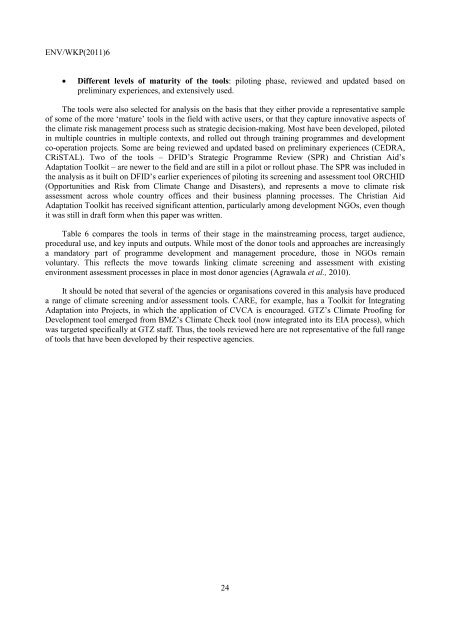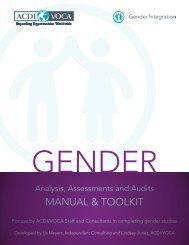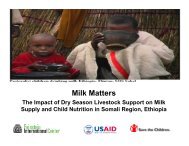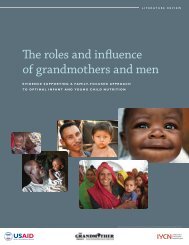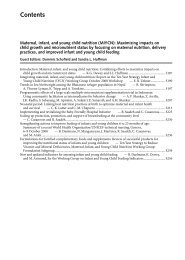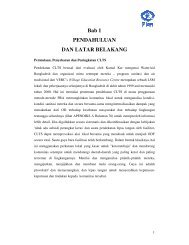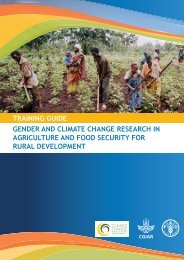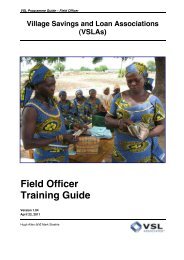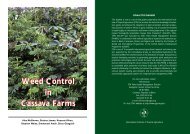ENV/WKP(2011)6• Although applied to pilot exercises and practical case studies, tools are difficult to access,compile and compare, owing to:o The use of different terminologies and the different types of analyses;o Different points of departure, where some tools focused on mainstreaming adaptation intoprojects while others focused on developing adaptation projects.• The levels of assumed prior knowledge of tool users differed, particularly in regards to climatechange. Some tools are ‘readily operational’, offering limited direction to users, while othersoffer step-by-step guidance to users, thereby requiring more time and resources to apply.3. Analysis of selected screening and assessment toolsThe examination of risk screening and assessment tools focuses on a selection of tools, representing across-section of the tools landscape. The analysis examines starting points in the creation of tools andexplores tool development processes. Further, it considers experiences gained in the application of tools.3.1 Selection of tools to be reviewedA wide range of Type 1 process guidance tools are available to help development decision-makersand practitioners integrate climate risks and adaptation into their work. Because screening and assessmenttools are continually being developed, revised and even retired, the analysis in this paper does not includeall of the tools reviewed in the UNDP or Klein et al. (2007) reports; instead it focuses on nine tools thatprovide a representative sample from which to draw more general conclusions.The starting point <strong>for</strong> this analysis is a small set of semi-structured interviews that were conducted inHavana, Cuba, in March 2009 on the margins of the UNFCCC Nairobi Work Programme (NWP) meetingon “Integrating practices, tools and systems <strong>for</strong> climate risk assessment and management and Disaster <strong>Risk</strong>Reduction (DRR) strategies into national policies and programmes.” Discussions with nine self-identifiedtool users indicated a wide range of professional responsibilities, capacities, and interests within the socalled‘adaptation practitioner’ community, to which many CRM/adaptation tools are targeted. Thishighlighted the potential <strong>for</strong> mismatch between tool developers’ intentions and tool users’ needs, as well asthe possibility that successfully applying the tool and feeding its results into policy and project decisionmakingprocesses would be largely shaped by the degree to which it accommodates people’s expectations,capacities, and priorities. Thus, the NWP interviews pointed to the need <strong>for</strong> a greater analysis of user needsand experiences.Building on this initial observation, this paper examines the tool development and applicationexperiences of nine climate risk (pre-) screening and/or assessment tools, five developed by donor agenciesand four developed by international NGOs. The sample of tools analysed, which is summarised in Table 6,was selected to ensure that it represented a cross section of various types of tools, with particularreferences to:• Different types of development agencies: donors (both bilateral and multilateral) andinternational NGOs;• Different stages of the process: <strong>for</strong> screening only, <strong>for</strong> assessment/analysis/evaluation only; andtackling all aspects of climate risk management (this typology is described in Section 2.2);23
ENV/WKP(2011)6• Different levels of maturity of the tools: piloting phase, reviewed and updated based onpreliminary experiences, and extensively used.The tools were also selected <strong>for</strong> analysis on the basis that they either provide a representative sampleof some of the more ‘mature’ tools in the field with active users, or that they capture innovative aspects ofthe climate risk management process such as strategic decision-making. Most have been developed, pilotedin multiple countries in multiple contexts, and rolled out through training programmes and developmentco-operation projects. Some are being reviewed and updated based on preliminary experiences (CEDRA,CRiSTAL). Two of the tools – DFID’s Strategic Programme Review (SPR) and Christian Aid’sAdaptation Toolkit – are newer to the field and are still in a pilot or rollout phase. The SPR was included inthe analysis as it built on DFID’s earlier experiences of piloting its screening and assessment tool ORCHID(Opportunities and <strong>Risk</strong> from <strong>Climate</strong> Change and Disasters), and represents a move to climate riskassessment across whole country offices and their business planning processes. The Christian AidAdaptation Toolkit has received significant attention, particularly among development NGOs, even thoughit was still in draft <strong>for</strong>m when this paper was written.Table 6 compares the tools in terms of their stage in the mainstreaming process, target audience,procedural use, and key inputs and outputs. While most of the donor tools and approaches are increasinglya mandatory part of programme development and management procedure, those in NGOs remainvoluntary. This reflects the move towards linking climate screening and assessment with existingenvironment assessment processes in place in most donor agencies (Agrawala et al., 2010).It should be noted that several of the agencies or organisations covered in this analysis have produceda range of climate screening and/or assessment tools. CARE, <strong>for</strong> example, has a Toolkit <strong>for</strong> IntegratingAdaptation into Projects, in which the application of CVCA is encouraged. GTZ’s <strong>Climate</strong> Proofing <strong>for</strong>Development tool emerged from BMZ’s <strong>Climate</strong> Check tool (now integrated into its EIA process), whichwas targeted specifically at GTZ staff. Thus, the tools reviewed here are not representative of the full rangeof tools that have been developed by their respective agencies.24


